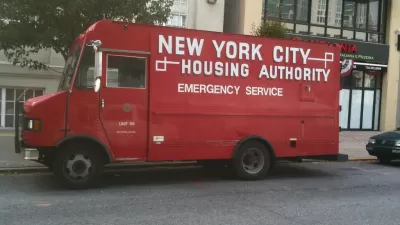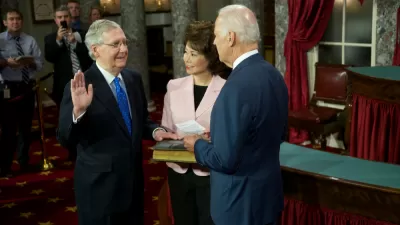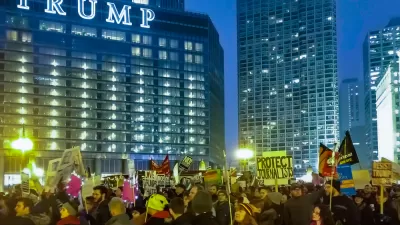Presidential budgets usually arrive with zero chance of being adopted without changes, but still important to consider as a reflection of the Executive Branch's priorities.

As reported by Damian Paletta, Erica Werner, and Jeff Stein, the Trump administration today revealed a $4.7 trillion budget plan "that stands as a sharp challenge to Congress and the Democrats trying to unseat him."
The budget calls for $8.6 billion for wall funding and a significant increase in defense spending.
Those priorities stand in contrast to proposed cuts to programs and projects related to the field of planning.
The U.S. Department of Housing and Urban Development put out a press release to explain its portion of the proposed budget, saying the Trump administration is proposing "a $44.1 billion spending plan that expands resources to prevent/end homelessness; invests record funding to reduce lead and other home health and safety hazards; and preserves rental assistance to HUD-assisted households."
The press release also notes that the budget would eliminate "ineffective programs," namely the Community Development Block Grant (CDBG) Program, the Choice Neighborhoods Initiative, the HOME Investment Partnerships Program, and the Self-Help Homeownership Opportunity Program (SHOP).
Justin Sink and Erik Wasson also provide insight into the Trump's budget proposal's big move against discretionary spending. "The proposal calls for reducing regular nondefense discretionary spending from $597 billion to $543 billion, a $54 billion, or 9% cut in 2020. When disaster-relief funding is factored in, the cut amounts to $28 billion, or 4.6%." Spending for the Department of Transportation and the U.S. Environmental Protection Agency (EPA) would face significant reductions in funding as a result. Another article by Jeff Davis (paywall) provides details on the $4.8 billion in funding the budget would cut from Department of Transportation appropriations.
Among the cuts to EPA programs is a third attempt by the Trump administration to cut funding for the Great Lakes Initiative. "It is the third year in a row that Trump has proposed either eliminating or cutting most of the program, which is used on projects to restore wetlands and improve water quality in and around the Great Lakes," according to an article by Todd Spangler. In total, the bduget would cut EPA funding by 31 percent, according to another article by Miranda Green.
Finally, an article by Tara Holshen details the effects the Trump budget would have on the social safety net—with cuts aimed at Medicare, Social Security, Medicaid, and more.
FULL STORY: Trump proposes $4.7 trillion budget with domestic cuts, $8.6 billion in new funding for border wall

Planetizen Federal Action Tracker
A weekly monitor of how Trump’s orders and actions are impacting planners and planning in America.

Maui's Vacation Rental Debate Turns Ugly
Verbal attacks, misinformation campaigns and fistfights plague a high-stakes debate to convert thousands of vacation rentals into long-term housing.

Restaurant Patios Were a Pandemic Win — Why Were They so Hard to Keep?
Social distancing requirements and changes in travel patterns prompted cities to pilot new uses for street and sidewalk space. Then it got complicated.

In California Battle of Housing vs. Environment, Housing Just Won
A new state law significantly limits the power of CEQA, an environmental review law that served as a powerful tool for blocking new development.

Boulder Eliminates Parking Minimums Citywide
Officials estimate the cost of building a single underground parking space at up to $100,000.

Orange County, Florida Adopts Largest US “Sprawl Repair” Code
The ‘Orange Code’ seeks to rectify decades of sprawl-inducing, car-oriented development.
Urban Design for Planners 1: Software Tools
This six-course series explores essential urban design concepts using open source software and equips planners with the tools they need to participate fully in the urban design process.
Planning for Universal Design
Learn the tools for implementing Universal Design in planning regulations.
Heyer Gruel & Associates PA
JM Goldson LLC
Custer County Colorado
City of Camden Redevelopment Agency
City of Astoria
Transportation Research & Education Center (TREC) at Portland State University
Jefferson Parish Government
Camden Redevelopment Agency
City of Claremont





























